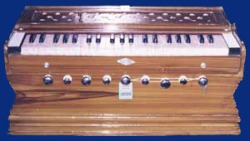Harmonium

The harmonium is also known as peti or baja. It is a European instrument which was imported in the 19th century. Harmonium is a reed organ with hand pumped bellows. The keyboard is European, but it has a number of drone reeds which are particularly Indian. European models came in both hand pumped and foot pumped models. The foot pumped models disappeared in India many years ago. This is because the foot pedals required one to sit in a chair; something which is unusual for an Indian musician. Also the only advantage of the foot model was that it freed both hands so that both melody and chords could be played. Indian music has no chords, so this was no advantage. Although the hand pumped models required one hand to pump they were more portable and comfortable when played on the floor Indian classical style.
The harmonium is a Western instrument adapted for Indian music, It is mainly used in the accompaniement of Khyal, Thumri and Qawwali The instrument has 42 black and white keys, corresponding to the equal temperament of Western music. The musician plays it with the right hand, and the left hand activates the bellow of the instrument. It is used as an accompmaniment in replacement of sarangi.
Parts of Harmonium
There are a number of parts of the harmonium, here are some of the main ones:
Body
The body is the box that houses the various parts of the harmonium. There are two basic styles. One style is simply a box with everything in a fixed position (see above illustration). Another style collapses down into a suitcase style of enclosure. There are several collapsible styles; one is shown in the right hand illustration.
Bellows
The bellows are the pumps which force the air through the instrument. There are really two sets of bellows, one internal and one external. The external bellows are pumped by hand; these are familiar to the average player. The external bellows then forces the air into the internal bellows. The internal bellows act as a reservoir for the air. These bellows lay deep inside the instrument and are visible only by disassembling the instrument. The internal bellows push against a spring; it is this spring which forces the air over the reeds.
Keys or chabi
The keys, known in India as "chabi", are the small wooden controls that the performer fingers to play the music. There are black keys and white keys. Although the keyboard is reminiscent of the keyboards found on pianos and other Western instruments, the international standard for pitch.
Cover
The cover is a small piece of wood, sometimes with cloth or glass, which covers the workings of the harmonium. It serves two functions. The most important is to protect the workings against damage. It also changes the sound by muting the higher frequencies while allowing the lower frequencies to pass. Sometimes the cover has a sliding panel which makes this muting action adjustable.
Reed Boad
The reed board is a flat piece of wood with a series of long holes cut in them. There are a series of brass reeds covering these holes. These reeds are arranged in banks. If there are two banks of reeds, it is said to be a double-reed harmonium. If there are three banks of reeds, it is said to be a triple-reed harmonium. The triple-reed harmonium is generally considered to be superior to the double-reed variety. Sometimes this board is not flat, but instead has the reeds set into perpendicular baffles. This style is said to produce a better sound.
Playing / Sitting Positions
This instrument is played on floor, there are two common sitting positions, a standard position and one used by qawwali singers. The standard position is simple. On simply places the harmonium on the ground. The right hand plays the keys while the left hand pumps the bellows. This is the most common position used in India today. There is also a position used by qawwali singers and folk musicians. For this position one end of the harmonium rests on the ground while the other end rest partially in the lap.
